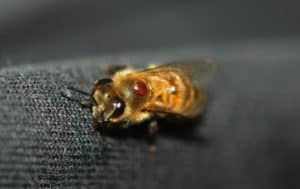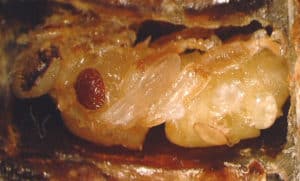The varroa mite (Varroa destructor) has caused widespread devastation to honey bees through vampire-like feeding on larval and adult bees which decreases normal adult honey bee size, shortens their lifespan and can transfer viruses between bee hosts. (Rosenkrantz et al. 2010).

Oxalic acid (CAS #144-62-7) has just been registered by the EPA for use on honey bee colonies here in the US. Oxalic acid has been legal to use on honeybees in Europe and Canada and is a naturally occurring chemical that can be found in a number of plants. It also occurs naturally in honey and is commonly used as wood bleach.

A few oxalic acid applications have been registered:
“Application Methods and Labeling
Oxalic Acid will be labeled for application by three different methods:
1. By Solution to Package Bees (Oxalic acid in sugar solution is applied as a spray to the package)
2. By Solution to the Beehives (Oxalic acid in sugar solution is trickled between frames and other spaces)
3. Vapor treatment of Beehives (Oxalic acid dehydrate is heated and the vapor sublimates in the hive.”
**from J.E. Housenger, EPA, Registration Decision for the New Active Ingredient Oxalic Acid
The most useful application method for side-liner and hobby beekeepers is trickling the oxalic/sugar syrup mixture between the frames. The product label includes important information on dose and personal protection equipment including, but not limited to: gloves, goggles and a respirator. It is particularly important to not breathe in the dust when you are preparing the solution. Be certain to read and follow the label directions to ensure the best results when treating your bees.

Always be sure to monitor your bees for varroa mites so that you know the mite load before you prophylactically treat your colonies. If you treat with the same synthetic chemical at each treatment, this continual exposure may cause the mites to develop resistance to that specific varroacide.
Additionally, treatments can negatively impact honey bee larval development and adult life span and should be applied only after the mite levels have crossed the threshold for treatment. That threshold is different for different operations. It is not likely that mites will develop resistance to a naturally occurring compound such as formic or oxalic acid as these acids desiccate mites and it is difficult to see a resistance developed to this mode of action.

***Check back here next Friday to learn how to non-destructively test for mites.
Reference:
Rosenkrantz, P. , P. Aumeier, B. Ziegelmann 2010. Biology and control of Varroa destructor. Journal of
Invertebrate Pathology, 103: S96-S119.